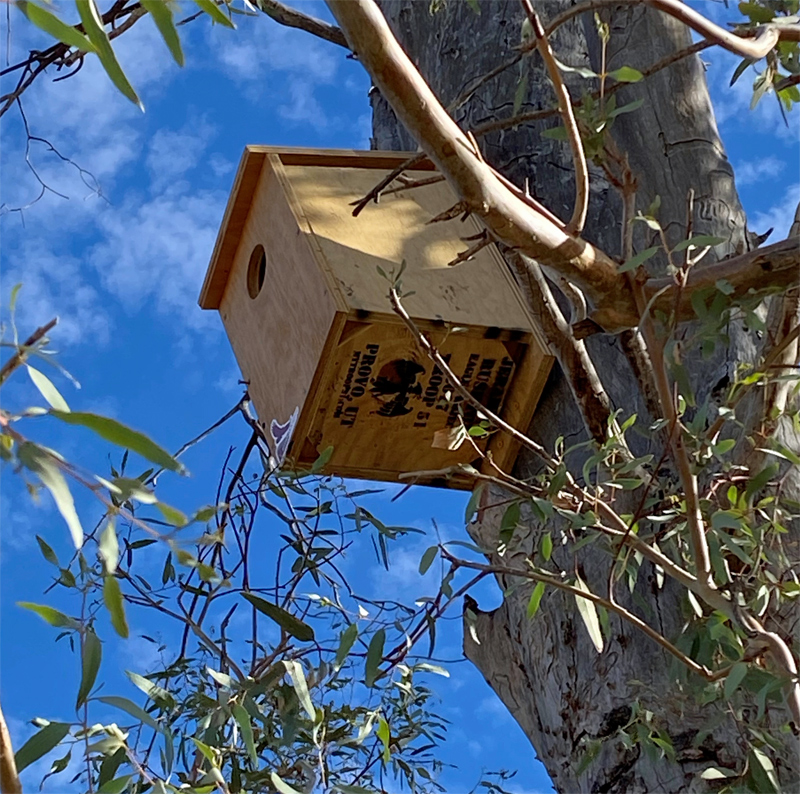If you’ve been in the Rio Vista eucalyptus grove lately, you’ve probably noticed at least one of two large wooden nest boxes mounted high in a tree. These boxes are part of a HawkWatch International long-term study of American kestrels (Falco sparverius). Mike Shaw, a member of the HawkWatch International board of directors and a Tucson resident, mounted the Rio Vista nest boxes with approval from Tucson Parks and Recreation. Mike has kindly provided background information on the kestrel project, including ways in which you can be involved (see below). If you’d like to contribute as an observer or nest monitor, please get in touch with Mike directly: mshaw@hawkwatch.org. We’re fortunate that Rio Vista was chosen as one of the project sites, and the Rio Vista Conservation Project is looking forward to coordinating with HawkWatch International and Tucson Audubon Society.
A message from Mike Shaw:
HawkWatch International is a nonprofit organization that works to protect raptors and our shared environment through scientific research and public education. One of their current projects in the western United States is focused on American kestrels, our smallest North American falcon. This colorful and relatively common bird has suffered recent steep declines, and a nationwide research effort has sprung up to answer the big question: why?
HawkWatch’s contribution is a large study (500+ nest boxes, 80+ citizen science volunteers) examining kestrel population dynamics and movements in and around Salt Lake City, combined with a smaller satellite study in northern Idaho. They’ve recently begun placing boxes in Tucson and outlying areas as a meaningful southern geographical addition. The largest central cluster here is a series of boxes along both sides of the Rillito from Flowing Wells through Craycroft Road, in concert with private landowners.

Rio Vista Natural Resource Park was identified as an important link in the Rillito cluster, and Tucson Parks and Recreation generously gave the go-ahead to place nest boxes within the park. Visitors might notice several boxes relatively close together in the southeast corner, chosen for its tall eucalyptus trees (falcons like high places) and visibility to park users (good science likes public awareness). Nesting kestrels usually protect their territory from other kestrels, so multiple boxes close together probably won’t result in more little falcons. But importantly, it should increase the chances of attracting one breeding pair by offering more options to choose from.
With luck, that will happen over the next several months as prospective nesters make their decisions. As a side note: Like kestrels, western screech owls are cavity nesters that readily take to nest boxes of the same size. HawkWatch commonly finds them in both their northern studies and happily incorporates screech owl data into associated raptor projects . . . after all, who doesn’t like adorable little owls?!
The success of both the Utah and Idaho kestrel projects depends on the efforts of dedicated citizen scientists, and HawkWatch and Tucson Audubon Society are currently discussing how to best involve interested volunteers in nest checks and data collection.
For people with existing nest boxes on their property: HawkWatch and Tucson Audubon Society would like to hear from you if you’re interested in joining the study, either by self-monitoring the box or by allowing access to volunteers during nesting season (approximately February through June).
For those interested in putting up a new box, whether joining the study or not, HawkWatch has building plans here: Build a Kestrel Nest Box. Tucson Audubon has boxes for sale in their Nature Shop (currently open but closed for walk-ins; please call 520-629-0510 for purchasing information).
HawkWatch International and Tucson Audubon Society would like to thank Tucson Parks and Recreation for their interest in the project.
For more information:
- https://hawkwatch.org/our-work/kestrels | Contact: Mike Shaw
- http://tucsonaudubon.org/nestbox | Contact: Olya Phillips
